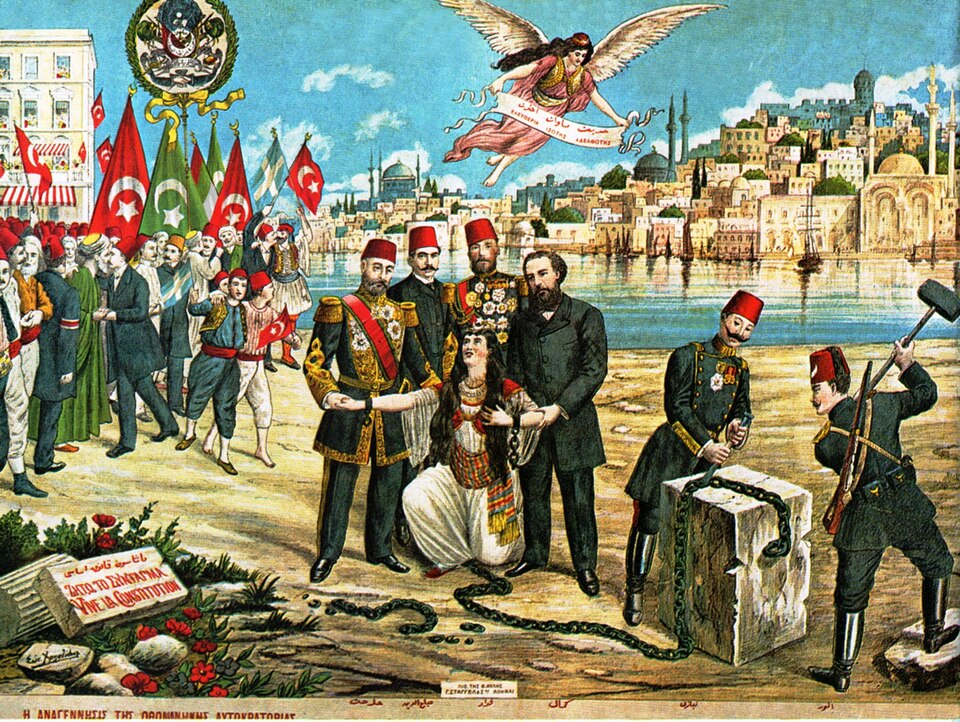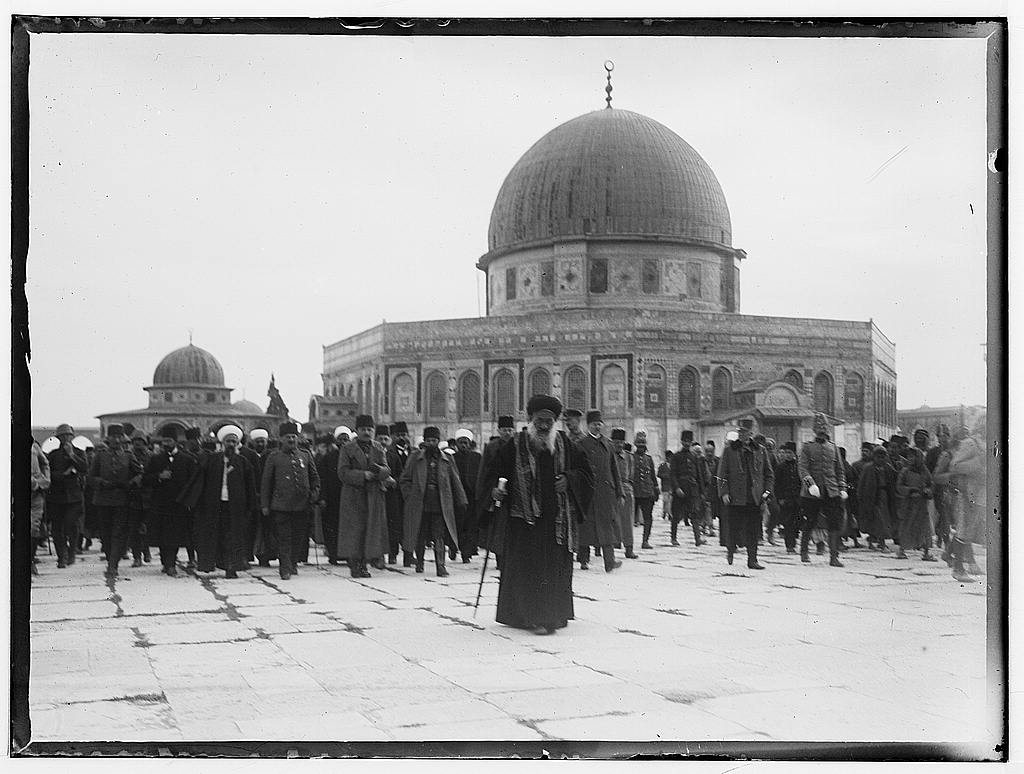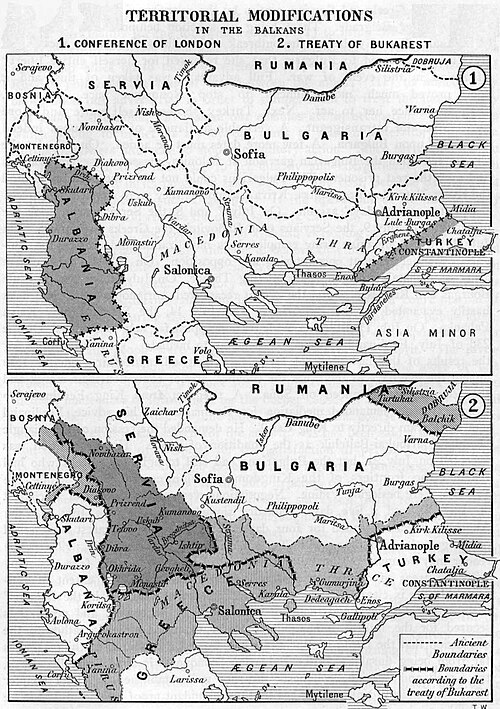IB Syllabus focus:
'Explore the rise of the Committee of Union and Progress leading to the Balkan Wars (1912 and 1913) and the reforms initiated by the Young Turks.'
Introduction
In the late 19th and early 20th centuries, the Ottoman Empire underwent a period of intense transformation under the Committee of Union and Progress (CUP), with reforms that redefined the empire's political landscape and set the stage for modern Turkey.
The Emergence of the Young Turks
The Young Turks were a revolutionary group advocating for the rejuvenation of the constitutional and parliamentary system of the Ottoman Empire, which Sultan Abdul Hamid II had suspended.
Origins and Ideological Foundations
Founding Ideals: The Young Turks, predominantly educated in Europe, were influenced by contemporary liberal and nationalist ideologies, which they sought to apply within the Ottoman context.
Unity and Diversity: Their original ideology, Ottomanism, aimed to create unity among the empire's diverse peoples through shared citizenship and equal rights.
The 1908 Young Turk Revolution
Momentum Gains: Discontent with Abdul Hamid's rule grew, leading to the Young Turk Revolution in July 1908, which restored the Ottoman constitution and parliament.

A contemporary lithograph celebrates the 1908 Young Turk Revolution and the restoration of the constitution, highlighting the movement’s inspirations and leaders alongside the slogan “Liberty, Equality, Fraternity.” As a commemorative print rather than a photograph, it visualizes the political ideals that animated the Second Constitutional Era. Source
Abdul Hamid's Abdication: Amidst the upheaval, Abdul Hamid II was deposed in 1909, and Mehmed V Reşad became Sultan, though the real power lay with the CUP.
The Committee of Union and Progress (CUP)
As the dominant political faction, the CUP's rise was both a symptom and a cause of the empire's transformation.
Ascendance to Power
From Fringe to Fore: The CUP transitioned from a clandestine organisation to the empire's de facto rulers after the 1908 revolution.
Internal Dynamics: The CUP was not monolithic and contained varying opinions and factions, often leading to internal strife.
Key Personalities
Enver, Talat, and Cemal Pashas: These three figures would dominate the CUP and Ottoman politics, each playing crucial roles in military and civil affairs.

Enver Pasha (center) and Cemal (Jamal) Pasha visit the Dome of the Rock during the CUP’s wartime rule, illustrating the prominence of the Young Turk triumvirs in imperial politics and military affairs. While taken in 1916, the image contextualizes the leaders highlighted in this section. Source
CUP and Nationalism
The CUP's initial commitment to inclusive Ottomanism gradually gave way to a more exclusive Turkish nationalism, contributing to ethnic tensions within the empire.
Shift Towards Turkish Nationalism
Rethinking Ottomanism: The repeated loss of predominantly Christian territories and the political reality of a shrinking empire pushed the CUP towards Turkish nationalism.
Impact on Ethnic Relations
Ethnic Rebellions: The move towards Turkish dominance exacerbated ethnic conflicts, particularly with Armenians, Arabs, and Greeks.
The Balkan Wars (1912-1913)
The Balkan Wars represented a critical juncture for the Ottoman Empire, showcasing its military vulnerabilities and accelerating territorial losses.
The First Balkan War
Immediate Causes: The formation of the Balkan League and its subsequent offensive in 1912 took the Ottomans by surprise, leading to severe defeats.
Territorial Losses: The empire lost almost all of its European territories, a significant blow that underlined the urgency for reform.

Map showing the borders of the Balkans after the First and Second Balkan Wars (1912–1913), highlighting the Ottoman Empire’s dramatic loss of European territory. This visual consolidates the geopolitical consequences that pressured the CUP to accelerate reform. Source
The Second Balkan War
Intra-Alliance Conflict: The Second Balkan War saw former allies fighting over the spoils, which allowed the Ottomans to regain some territory in Eastern Thrace.
Young Turk Reforms
The Young Turks embarked on a broad reform program affecting various aspects of the Ottoman state and society.
Political Reforms
The CUP sought to transform the empire into a modern state through comprehensive political restructuring.
Constitutional Developments
1909 Constitution: An amended constitution aimed to curtail the Sultan's powers and enhance parliamentary governance.
Parliamentary Life
Elections and Parties: While elections were held and political parties existed, the CUP maintained a tight grip on political life, often manipulating outcomes.
Administrative Reforms
Efforts were made to streamline administration and integrate various provinces more effectively into the state apparatus.
Redefining Provincial Administration
Centralisation Efforts: The CUP reorganised provincial governments to enforce central control and reduce the power of local notables.
Educational Reforms
Education was seen as a means to modernise the nation and create a cohesive identity.
Building a Modern School System
New Institutions: The CUP expanded the network of state schools, including secondary and technical institutions.
Curricular Overhauls: Curricula were standardised and secularised to reflect the Young Turk vision of a modern, unified society.
Military Reforms
The military was a focus of the Young Turks, who understood that reforming the army was crucial for the empire's survival.
Modernisation of the Army
German Influence: German military advisers were instrumental in reshaping the Ottoman army, leading to significant changes in training and organisation.
Naval Reinforcement
Naval Projects: Despite limited funds, there were attempts to modernise the Ottoman navy, seen as essential for protecting the empire's extensive coastlines.
Economic Reforms
Economic independence and modernisation were key goals for the CUP, leading to numerous initiatives.
Infrastructure and Development
Railways and Telegraphs: Extensive railway and telegraph networks were developed to facilitate communication, troop movement, and promote economic integration.
Financial Policies
Tax Reforms: The CUP attempted to improve tax collection methods to increase state revenue and reduce reliance on foreign loans.
Cultural Reforms
Culture and identity were another battleground for the Young Turks, who sought to create a unified national culture.
Language and Education
Turkification: The Turkish language was promoted in administration and education, marginalising minority languages.
Press Freedom and Censorship
Censored Press: While the Young Turks initially advocated for press freedom, they increasingly censored critical voices, especially during wartime.
Legal Reforms
The Young Turks aimed to modernise the legal system, taking inspiration from European legal traditions.
Codification of Laws
Legal Secularisation: New legal codes were introduced, reducing the role of Islamic law in the secular sphere.
Judicial Reorganisation
Judiciary Overhaul: The legal system was centralised, with new courts and legal procedures aiming to standardise the rule of law across the empire.
Legacy and Impact
The Young Turk era left an indelible mark on the Ottoman Empire and the Middle East, setting the stage for the rise of the modern Turkish state and profoundly influencing the region's subsequent history.
Repercussions of Reform
Socio-Political Changes: The reforms brought about by the Young Turks drastically altered the social and political fabric of the Ottoman Empire.
Ethnic and Nationalist Movements: The policies of Turkification and centralisation fuelled nationalist sentiments among non-Turkish groups, leading to further fragmentation.
The Prelude to Atatürk’s Reforms
Foundations for the Future: Many of the Young Turk reforms would later be expanded upon by Mustafa Kemal Atatürk, as he sought to establish a secular, nationalist state from the remnants of the Ottoman Empire.
This complex era of Ottoman history demonstrates the challenges of modernisation and nationalism within a multi-ethnic empire, providing invaluable lessons for understanding the dynamics of imperial decline and state-building.
FAQ
The Young Turk reforms only marginally addressed the status of women in Ottoman society. There were some advancements, such as improved access to education for girls and a slight increase in the visibility of women in the public sphere. However, these changes were primarily focused on the urban and elite segments of the population and did not significantly alter the patriarchal structure of Ottoman society. The CUP's reforms were predominantly nationalist and militarist in character, and gender equality was not a central tenet of their agenda. It was not until the Kemalist reforms following the establishment of the Republic of Turkey that women's rights became a more prominent issue.
The economic objectives of the Young Turks centred on achieving financial independence and modernising the economy. They sought to reduce reliance on foreign loans and improve tax collection methods. Infrastructure projects, particularly the development of railways and telegraph lines, were key components of their economic reform efforts. However, their success was mixed. While they did manage to extend the railway network, facilitating better communication and trade within the empire, their financial reforms were less effective. The Ottoman economy remained heavily indebted, and the centralised tax collection system was not entirely successful in increasing revenues, partially due to ongoing political turmoil and the empire's entry into World War I.
The Young Turks' legal reforms were heavily influenced by European legal traditions as they sought to secularise and modernise the Ottoman legal system. This influence is evident in the adoption of codes and legal procedures that mirrored those found in European countries. The Young Turks introduced a new civil code, commercial code, and maritime code, all based on European models, particularly the Swiss, German, and French systems. These reforms aimed to create a more secular legal framework, reducing the influence of Islamic law except in personal matters. They also overhauled the judiciary, establishing a network of secular courts and developing a more centralised legal administration, indicative of the contemporary European approach to jurisprudence.
The CUP’s shift from Ottomanism to Turkish nationalism significantly heightened ethnic tensions. Policies such as the Turkification of education and the imposition of Turkish as the primary language of administration marginalised non-Turkish populations, particularly Arabs, Armenians, and Greeks. Moreover, the CUP’s centralisation efforts reduced the autonomy of diverse regions, ignoring the complex mosaic of ethnicities and cultures within the empire. This led to various uprisings and discontent among minority groups who felt their cultural and political rights were being suppressed. These tensions would later manifest in tragic events, such as the Armenian Genocide during World War I, for which the CUP leadership bears significant responsibility.
The Young Turk's educational reforms were a microcosm of their broader political objectives, which centred around the creation of a secular, homogeneous, and nationalistic society. By expanding the network of state schools and secularising the curriculum, they intended to foster a unified national identity among the empire's diverse populations. The promotion of the Turkish language at the expense of minority languages in schools was a direct attempt to assimilate various ethnic groups into a single Turkish national identity. Furthermore, the introduction of technical and vocational education aimed to cultivate a skilled workforce, capable of advancing industrial and economic growth in line with the modernisation efforts of the Young Turk regime.
Practice Questions
The Young Turk reforms had a profound impact on the administrative structure of the Ottoman Empire. They centralised administrative control, reducing the power of local notables and bringing provinces directly under the state's purview. This was a double-edged sword; while it modernised the state apparatus and aimed for greater efficiency, it also stoked discontent among local elites and non-Turkish populations. Centralisation under the CUP effectively dismantled the feudal structure that had previously allowed diverse communities some degree of autonomy. In theory, these reforms were meant to create a more equitable system, but in practice, they often exacerbated ethnic tensions by enforcing a Turkish-centric ideology.
The Committee of Union and Progress played a pivotal role in the lead-up to the Balkan Wars. As the de facto rulers of the Ottoman Empire, they were responsible for the policies that partly led to this conflict. Their efforts to centralise power and Turkify the administration alienated many Balkan communities, fuelling nationalist sentiments. Additionally, the CUP’s focus on internal reform meant that the empire was militarily underprepared for the rapid onset of the Balkan Wars. While they sought to modernise the empire and bolster its territorial integrity, their policies inadvertently weakened its European position, leaving it vulnerable to the Balkan League's aggression.

